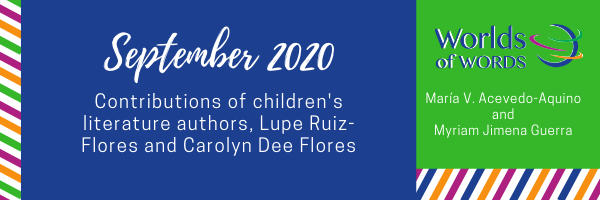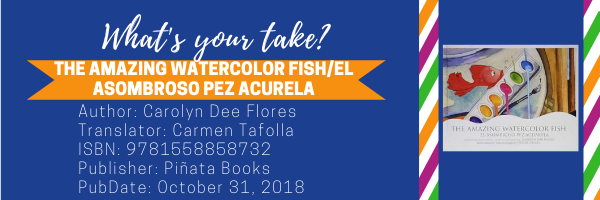By María V. Acevedo-Aquino and Myriam Jimena Guerra, Texas A&M University-San Antonio, San Antonio, TX

This month Myriam Jimena and María explore the contributions of two authors of children’s literature living in San Antonio, TX: Lupe Ruiz-Flores and Carolyn Dee Flores (mother and daughter). The five bilingual books selected depict strong characters willing to take action to improve their own lives and communities. This week they look at two fish who will rely on each other to imagine and hope in The Amazing Watercolor Fish/El asombroso pez acurela.

MARÍA: In this creative bilingual story, a lonely fish wonders about the world beyond her fishbowl: “I wish I knew what life held there. If it is gray. If it is bare.” She imagines a tall palm tree, a goat, a purple sea and even another fish. She leans to the glass and hears fish-like cries: “Hello? Is someone there? Are you a bird? Are you a bee? Or are you a fish with fins like me? By the way, my name is Mike.” The lonely fish decides to take her watercolors and show Mike what could be. She paints a picture of a world with rainbow swirls, planets and castles. Mike wants more everyday, so the fish paints “birds that swim and ships with wings, and books that do all sorts of things!” Everyday Mike also shows her a world full of stars and a big ocean. At the end of each day, both fish know a little bit more about their worlds beyond the bowl.
In this story, the exploration of art, particularly watercolor, as a vehicle to imagine, and collaboratively create a new world, a better world is powerful. I also love that the Spanish translation was written by former Texas Poet Laureate, Carmen Tafolla.
MYRIAM JIMENA: Yes, children all over the planet will be mesmerized with these two curious and creative fish. This story can challenge the perspective that young children can’t see beyond what is shown to them. On the contrary, the narrative describes a powerful metaphor through the swirls of the story, in which readers reaffirm that imagination has the power to change a plain white and gray palette to a marvelous and colorful reality. Mike wonders, “I wish I knew what life held there….” This powerful sentence will ignite young critical readers to know more about their own reality and surroundings. An empowering message to seek, without fear, what is beyond the walls–a strong metaphor to support children who might feel isolated during quarantine.
MARÍA: Your reference to counter narratives reminds me that often education for bilingual students focuses on vocabulary and simple grammatical structures. I enjoy how this story also challenges deficit views on bilingual children by offering a lyrical story that addresses imagination, creativity and children’s agency over their own learning. As the fish says towards the end of the story, “Cause when the day is finally through, I know much more than what I knew.” The fish learn through each other, by sharing and responding to each other’s watercolor paintings. The story employs rhyming and complex language that conveys possibilities and problem-solving. During this moment of COVID-19, the story can encourage readers to explore the power of art and rhyming as means to escape and/or transform reality.
MYRIAM JIMENA: Simultaneously, the storyline takes the readers to a progressively rich narrative. This bilingual book doesn’t use a direct or literal translation, instead, it relies on context, and also on the deeper meaning or intention of the English version to display innovative and figurative language. I see Tafolla’s translation as a trendsetting way to use a culturally and linguistically relevant approach. Both narratives are written in the original language English and Spanish, which allows us to appreciate the unique linguistic features of each language, such as the richness of words, rhythm and a variety of sentence structures. The fish asks if someone is there: “Are you a bird? Are you a bee? Are you a fish with fins like me?” The sentences rhyme. In the bilingual version, the sentences capture the wordplay effect: “¿Eres un pájaro azul? ¿O abeja rayada? ¿O pez como yo con aleta ondulada?” Thus, achieving rhyming in Spanish too, while adding even more descriptions to the characters as the narrative progresses.
Title: The Amazing Watercolor Fish/El asombroso pez acurela
Author: Carolyn Dee Flores
Translator: Carmen Tafolla
ISBN: 9781558858732
Publisher: Piñata Books
PubDate: October 31, 2018
Throughout September 2020, Myriam Jimena and María explore the contributions of two authors of children’s literature living in San Antonio, TX: Lupe Ruiz-Flores and Carolyn Dee Flores (mother and daughter). Check back each Wednesday to follow the conversation!

Loved the article! I am very proud of my daughter, Carolyn Dee, for writing and illustrating this picture book. I am also so happy that our friend, Poet Laureate Carmen Tafolla did the Spanish translation. Children love this book. Muchisimas gracias.